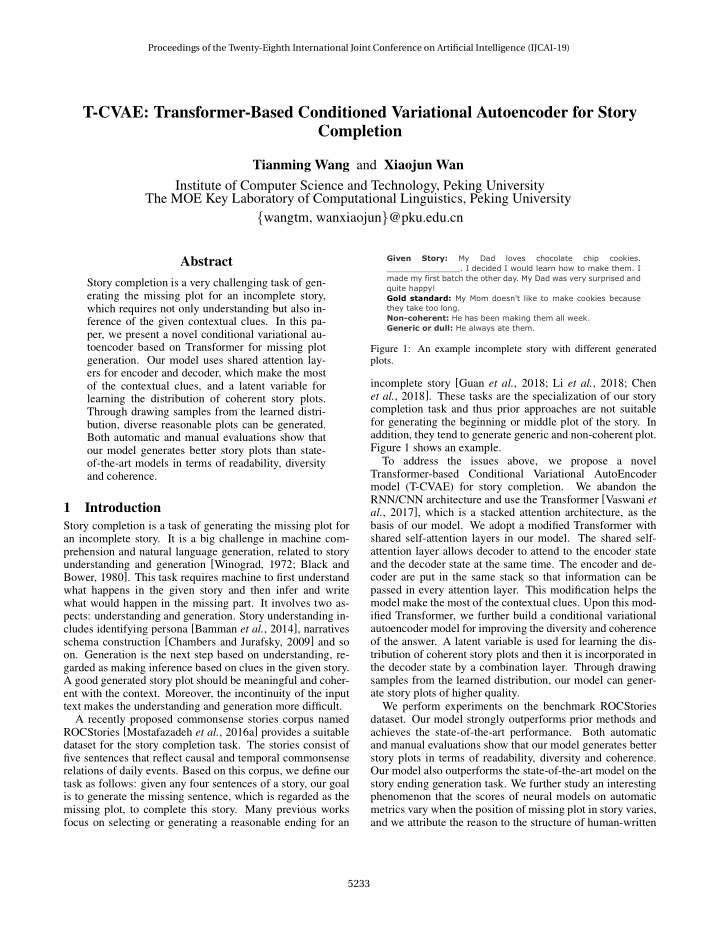



Proceedings of the Twenty-Eighth International Joint Conference on Artificial Intelligence (IJCAI-19) T-CVAE: Transformer-Based Conditioned Variational Autoencoder for Story Completion Tianming Wang and Xiaojun Wan Institute of Computer Science and Technology, Peking University The MOE Key Laboratory of Computational Linguistics, Peking University { wangtm, wanxiaojun } @pku.edu.cn Given Story: My Dad loves chocolate chip cookies. Abstract _______________. I decided I would learn how to make them. I made my first batch the other day. My Dad was very surprised and Story completion is a very challenging task of gen- quite happy! erating the missing plot for an incomplete story, Gold standard: My Mom doesn't like to make cookies because they take too long. which requires not only understanding but also in- Non-coherent: He has been making them all week. ference of the given contextual clues. In this pa- Generic or dull: He always ate them. per, we present a novel conditional variational au- toencoder based on Transformer for missing plot Figure 1: An example incomplete story with different generated generation. Our model uses shared attention lay- plots. ers for encoder and decoder, which make the most incomplete story [Guan et al. , 2018; Li et al. , 2018; Chen of the contextual clues, and a latent variable for et al. , 2018]. These tasks are the specialization of our story learning the distribution of coherent story plots. completion task and thus prior approaches are not suitable Through drawing samples from the learned distri- for generating the beginning or middle plot of the story. In bution, diverse reasonable plots can be generated. addition, they tend to generate generic and non-coherent plot. Both automatic and manual evaluations show that Figure 1 shows an example. our model generates better story plots than state- To address the issues above, we propose a novel of-the-art models in terms of readability, diversity Transformer-based Conditional Variational AutoEncoder and coherence. model (T-CVAE) for story completion. We abandon the RNN/CNN architecture and use the Transformer [Vaswani et 1 Introduction al. , 2017], which is a stacked attention architecture, as the basis of our model. We adopt a modified Transformer with Story completion is a task of generating the missing plot for shared self-attention layers in our model. The shared self- an incomplete story. It is a big challenge in machine com- attention layer allows decoder to attend to the encoder state prehension and natural language generation, related to story understanding and generation [Winograd, 1972; Black and and the decoder state at the same time. The encoder and de- Bower, 1980]. This task requires machine to first understand coder are put in the same stack so that information can be what happens in the given story and then infer and write passed in every attention layer. This modification helps the what would happen in the missing part. It involves two as- model make the most of the contextual clues. Upon this mod- pects: understanding and generation. Story understanding in- ified Transformer, we further build a conditional variational cludes identifying persona [Bamman et al. , 2014], narratives autoencoder model for improving the diversity and coherence schema construction [Chambers and Jurafsky, 2009] and so of the answer. A latent variable is used for learning the dis- on. Generation is the next step based on understanding, re- tribution of coherent story plots and then it is incorporated in garded as making inference based on clues in the given story. the decoder state by a combination layer. Through drawing A good generated story plot should be meaningful and coher- samples from the learned distribution, our model can gener- ent with the context. Moreover, the incontinuity of the input ate story plots of higher quality. text makes the understanding and generation more difficult. We perform experiments on the benchmark ROCStories A recently proposed commonsense stories corpus named dataset. Our model strongly outperforms prior methods and ROCStories [Mostafazadeh et al. , 2016a] provides a suitable achieves the state-of-the-art performance. Both automatic dataset for the story completion task. The stories consist of and manual evaluations show that our model generates better five sentences that reflect causal and temporal commonsense story plots in terms of readability, diversity and coherence. relations of daily events. Based on this corpus, we define our Our model also outperforms the state-of-the-art model on the task as follows: given any four sentences of a story, our goal story ending generation task. We further study an interesting is to generate the missing sentence, which is regarded as the phenomenon that the scores of neural models on automatic missing plot, to complete this story. Many previous works metrics vary when the position of missing plot in story varies, focus on selecting or generating a reasonable ending for an and we attribute the reason to the structure of human-written 5233
Recommend
More recommend